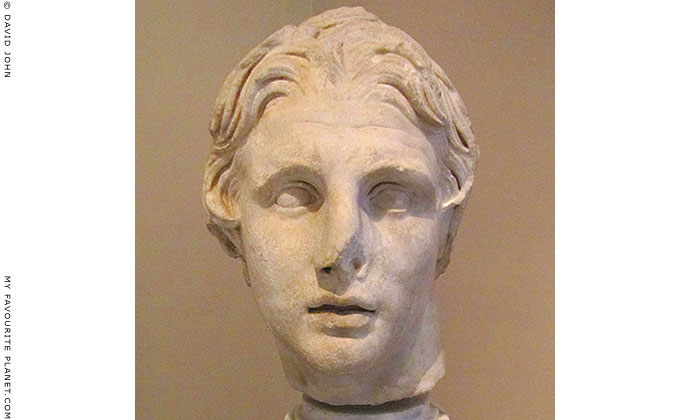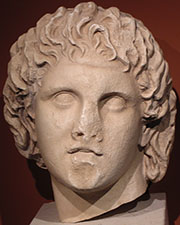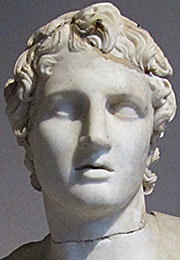|
|
|
| My Favourite Planet > English > Middle East > Turkey > Pergamon > gallery 2 |
| Pergamon gallery 2 |
Pergamon art |
 |
 |
2 of 26 |
 |
 |
|
| |

Marble head of Alexander the Great from Pergamon.
2nd century BC. Istanbul Archaeological Museum. |
| |
The marble head of Alexander the Great [1], dated to the 2nd century BC, was discovered in Autumn 1900, during excavations at the Lower Agora of the Pergamon Acropolis, and is thought to have been made in the city.
The head is now one of the most popular attractions in the Istanbul Archaeological Museum. There are are also plaster casts in the Bergama Museum and the Pergamon Museum, Berlin.
Alexandros III of Macedonia (Ἀλέξανδρος ὁ Μέγας, Alexandros o Megas, Alexander the Great, 356-323 BC), son of Philip II of Macedonia (382-336 BC).
Alexander is said to have studied Xenophon's book Anabasis (which includes the earliest known historical mention of Pergamon, see History of Pergamon) as a field guide to Anatolia before embarking on his campaign against the Persian king Darius III. In 334 BC Alexander defeated Darius on the River Granicus (near modern Çanakkele). As he marched through western Anatolia, Pergamon surrendered to him, and he appointed Barsine, the widow of the Persian commander, as administrator.
After Alexander the Great's death in 323 BC, his generals and relations (the Diadochi, or successors) waged war on each other for control of parts of his empire. Eventually, in 301 BC Lysimachus (360-281 BC), king of Thrace, took control of western Anatolia, including Pergamon. With the great riches he had accumulated as the spoils of war, he began rebuilding ancient cities such as Ephesus, and several new cities appeared in Anatolia.
Alexander is said to have taken great care in choosing artists to portray him and deciding how he should be represented. Apart from the type of portrait above, the original of which is thought to be by his personal sculptor Lysippos, he was also shown in sculpture and coins in the guise of a god such as Herakles, Ammon or Pan to ascert his claims to divine descent. See images on Pella gallery, page 5, in the My Favourite Planet guide to Pella, Macedonia Greece.
Many of the orginal sculptures of Alexander were made in bronze, though until now no complete bronzes of him have been unearthed. However, in February 2010 Greek authorities arrested two men accused of illegally possessing antiquities, including a bronze statue of Alexander. Experts and the press got very excited about the possibility that it could be an original work of Lysippos, and it was taken to the the laboratory of the Thessaloniki Archaeological Museum for examination. If the piece is authentic, it would be the only original work by Lysippos and the first complete bronze of Alexander yet discovered. |

Marble head of Alexander
the Great. End of the
4th century BC.
Pella Archaeological
Museum |
| |

Alexander the Great.
Detail of an over life-sized
marble statue, signed by
Menas of Pergamon. From
Magnesia ad Sipylum, Lydia
(Manisa, Turkey) [2].
Mid 3rd century BC.
Istanbul Archaeological
Museum. Inv. No. 709.
Cat. Mendel 536. |
| |
See more images of Alexander the Great
on the Alexander the Great page
in the My Favourite Planet People section. |
Pergamon
gallery 2 |
Notes, references and links |
 |
|
1. Head of Alexander the Great from Pergamon
Marble. Height 42 cm.
Hellenistic period, first half of the 2nd century BC.
Istanbul Archaeological Museum.
Inv. No. 1138 T. Cat. Mendel 538.
See: Gustave Mendel (1873-1938), Catalogue des sculptures grecques, romaines et byzantines, Tome Second, pages 254-255. Musée Impérial, Constantinople (Istanbul), 1914.
This sculpture and many of the other exhibits in the Istanbul Archaeological Museums were described in a large three-volume catalogue in French, compiled between 1912 and 1914 by Gustave Mendel (1873-1938) who was the curator of the museum, then known as Müze-i Hümayun (the Imperial Museum).
Mendel's Catalogue des sculptures grecques, romaines et byzantines, usually abbreviated to "Cat. Mendel", remains an important work for scholars, and its numbering sequence for museum objects is still used for reference.
According to one theory, the head may be that of a giant from the Gigantomachy frieze of the Great Altar of Zeus.
2. Statue of Alexander the Great from Manisa
See more photos of this statue on the Alexander the Great page in the MFP People section.
Mid 3rd century BC. White marble. Height 190 cm.
Istanbul Archaeological Museum. Inv. No. 709. Cat. Mendel 536.
An over life-size marble statue of Alexander the Great, wearing a himation (cloak) around his
left shoulder and lower body, and with his left hand holding the handle of his sheathed sword.
Excavated in 1895 by K. Buresch at the sanctuary of Meter Sipylene (Kybele), on the slopes of Mount Syplos, Magnesia ad Sipylum, Lydia (Manisa, western Turkey). Found with a marble base inscribed with a dedication to Meter Sipylene, the local mother goddess, and the signature of Menas of Pergamon:
Μηνᾶς Αἴαντος Περγαμηνὸς ἐποίησεν
(Menas Aiantos Pergamenos epoisen)
Menas of Pergamon, son of Aias, made [it]
Inscribed marble base, also in Istanbul Archaeological Museum.
Inv. No. 744 T. Cat. Mendel 537.
Inscription: Tituli Asiae Minoris, TAM V 2, 1358.
See: Gustave Mendel (1873-1938), Catalogue des sculptures grecques, romaines et byzantines, Tome Second, pages 249-254. Musée Impérial, Constantinople (Istanbul), 1914. |
|
|
Maps, photos and articles: © David John,
except where otherwise specified.
Additional photos: © Konstanze Gundudis
All photos and articles are copyright protected.
Images and materials by other authors
have been attributed where applicable.
Please do not use these photos or articles without permission.
If you are interested in using any of the photos for your website,
project or publication, please get in contact.
Higher resolution versions are available on request. |
| |
 |
Visit the My Favourite Planet Group on Facebook.
Join the group, write a message or comment,
post photos and videos, start a discussion... |
|
|
| |
|
|
|